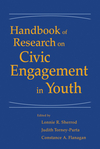I am paid to write about the civic and political engagement of young Americans. Many people who are interested in this topic believe that today’s younger adults, often called the Millennials (born 1985-2004), have distinctive and admirable attributes that will help to remedy the deep problems that we older people have created for them. Chief among their distinctive characteristics are a propensity to serve (marked by record-high volunteering levels), appreciation of diversity, creativity and entrepreneurship, and resistance to the dead-end ideological debates and culture wars of the previous decades.
The portrait is controversial and subject to much debate. For example, I keep on my shelf the following pair of books. Generation We by Eric Greenberg and Karl Weber is subtitled, How American Youth are Taking Over America and Changing Our World Forever. Norman Lear provides one of many enthusiastic endorsements on the back cover: “The Bible tells us, ‘a little child shall lead them.’ … Greenberg and Weber chronicle today’s wonderful young people as they push, pull, and propel us toward global salvation.” But I also own The Dumbest Generation by Mark Bauerlein, subtitled How the Digital Age Stupefies Young Americans and Jeopardizes Our Future, or Don’t Trust Anyone Under 30. The back cover warns: “If they don’t change, they will be remembered as fortunate ones who were unworthy of the privileges they inherited. They may even be the generation that lost that great American heritage, forever.”
If these books are witnesses for the defense and the prosecution, I would give my ultimate vote to the defense. I think the positive trends (rising volunteering rates, strong turnout in 2004 and 2008, and tolerant attitudes) outweigh the negative ones (record-low interpersonal trust and news media use)–while other measures of civic engagement (such as students’ knowledge of politics) are remarkably flat. Although there is nothing inevitably good about youth movements–European fascism was an important example–this generation inspires somewhat more hope than fear in me.
On the other hand, the whole business of making a case for or against a generation should be viewed with suspicion, for four reasons. First, generations are arbitrary constructs: babies are born every second, and all the important trends in civic engagement are smoothly continuous, not broken suddenly at twenty-year intervals. Second, there are many aspects of civic engagement, and some rise while others fall. Third, people born around the same time can have totally different formative experiences. For example, about one third of young Americans are not graduating from high school today, and they come of age in very different circumstances from their contemporaries who attend four-year colleges. The gaps in volunteering and voting rates by educational experience are vastly larger than any differences among generations. (Almost three quarters of young college graduates voted in 2008, compared to 26% of young high school dropouts.)
Finally, we do not know how the current generation of younger adults will turn out over their life course. The children of post-War suburbs who bought Davey Crocket hats and acted like Charlie Brown and Lucy were wearing dashikis and love beads a decade later. Today’s generation had early experiences with peace and prosperity, but more recently have faced the longest war in American history and the deepest recession since the Great Depression. To the extent that they have typical formative experiences, we cannot yet say what those experiences will be.
Notwithstanding all those caveats, there is something to the idea of social reform through generational mobilization. In the 1920s, Karl Mannheim argued that younger adults have valuable roles as critics, reformers, and renewers of society, even as elders contribute experience, and people in their middle years hold most of the managerial responsibility. Furthermore, when one is born affects one’s development as a citizen, even though other factors also matter. It is important that today’s youth grew up with Facebook and two wars in the Middle East, instead of Walter Cronkite and war in South East Asia.
Thus one does not need a strongly positive evaluation of the Millennials to motivate a commitment to youth civic engagement. It is always valuable to get younger adults constructively involved, and to do so effectively requires careful attention to their particular traits. Each cohort has distinctive assets and challenges which one must understand to develop strategies for civic renewal. With regard to the current generation of young adults, the most salient characteristics appear to be a fondness for online social networking, experience with volunteer service, comfort with diversity, unprecedentedly high levels of support for the winning presidential candidate (in 2008), low interpersonal trust, and low levels of formal group membership. This is the mixture of which something valuable can and must be made.
 Today I received my copy of the Handbook of Research on Civic Engagement in Youth, edited by the star team of Lonnie R. Sherrod, Judith Torney-Purta, and Constance A. Flanagan. It provides 706 large pages–24 chapters by 53 authors–about how, why, and when young people participate in politics and civic life.
Today I received my copy of the Handbook of Research on Civic Engagement in Youth, edited by the star team of Lonnie R. Sherrod, Judith Torney-Purta, and Constance A. Flanagan. It provides 706 large pages–24 chapters by 53 authors–about how, why, and when young people participate in politics and civic life.
